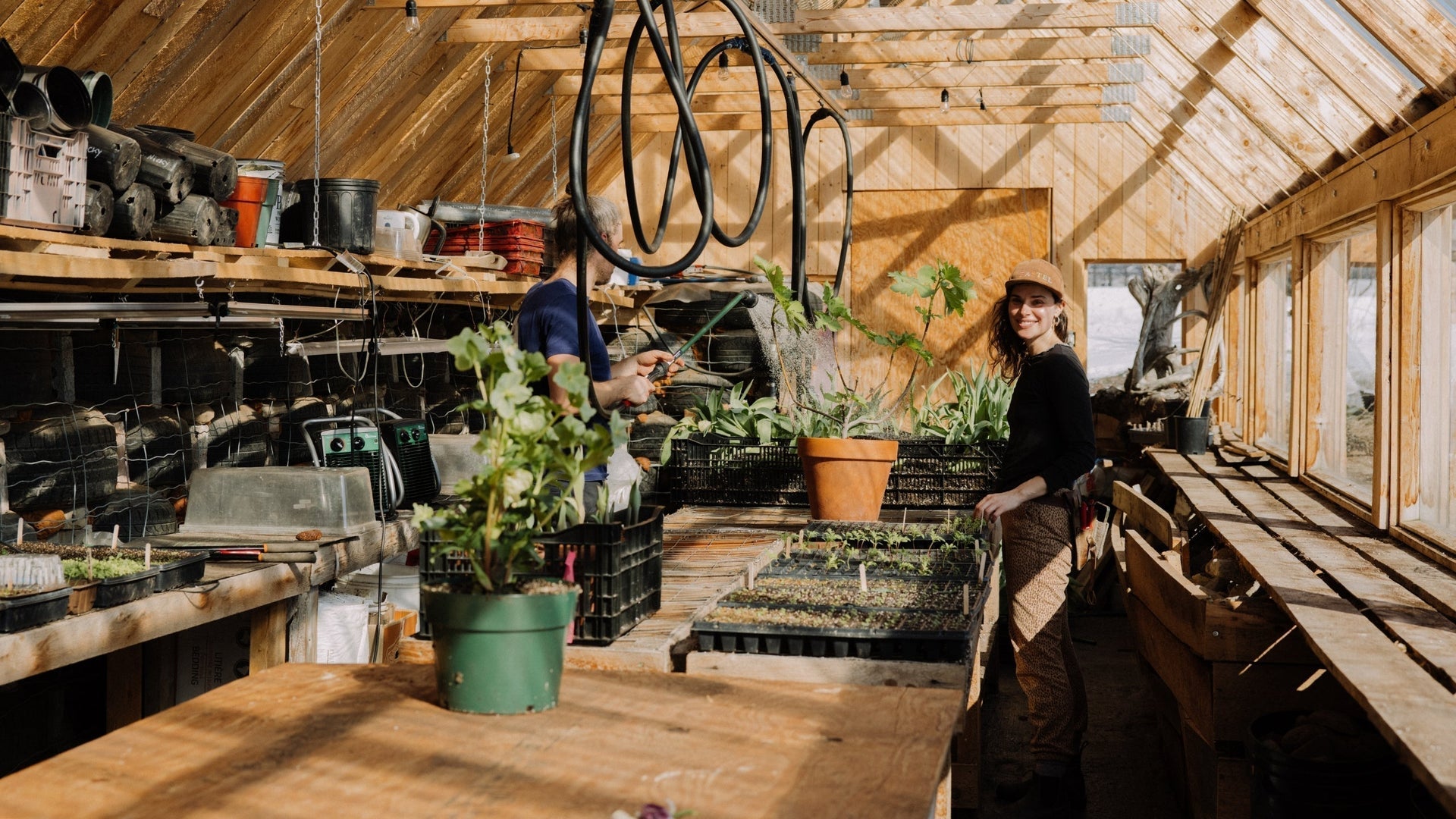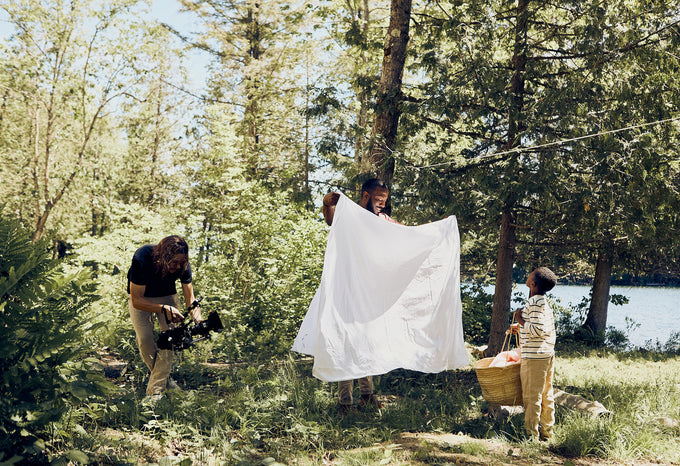Small outbuildings and greenhouses powered by renewable energy spread across the snow-covered fields of Grand-Métis, sheltering the beauty that Ora-Maggie Beaulieu-Pelletier and Skot Morgan lovingly cultivate. The owners of Ferme Pastel are on a mission to produce the most eco-friendly flowers possible — locally, and almost exclusively in winter.
Inside the Earthship-style greenhouse, Skot is busy planting eucalyptus seedlings and dividing dahlia tubers, while cats bask in the sun. It’s warm and bright despite the thick winter blanket still covering the yard. “A passive solar greenhouse feels like a secret island in a sea of white. Seeing the first flowers bloom while surrounded by snow — it’s magical,” Maggie says with a smile. The couple built this greenhouse themselves using recycled materials — tires, bottles, clay. It uses thermal mass to naturally capture, store, and redistribute heat.
 In the larger greenhouse, which is heated using biomass from local forestry residues, Maggie gathers the last tulips of the season — blooms that brightened many a heart this past Valentine’s Day. Between two rows of dormant flowers awaiting the next holiday rush, their daughters, Leonne and Alfée, pitch in however they can. One moment they’re watering tulip bulbs with their dad, the next they’re munching on lettuce leaves from the family’s winter garden. “I never have to worry whether they’re getting enough vegetables — they’re like little herbivores,” Maggie says with a laugh.
In the larger greenhouse, which is heated using biomass from local forestry residues, Maggie gathers the last tulips of the season — blooms that brightened many a heart this past Valentine’s Day. Between two rows of dormant flowers awaiting the next holiday rush, their daughters, Leonne and Alfée, pitch in however they can. One moment they’re watering tulip bulbs with their dad, the next they’re munching on lettuce leaves from the family’s winter garden. “I never have to worry whether they’re getting enough vegetables — they’re like little herbivores,” Maggie says with a laugh.
 Ferme Pastel is, first and foremost, a family endeavour. Maggie grew up on her parents’ organic farm in Grand-Métis. After studying social work, she felt a visceral pull back to the land. On a small flower farm in British Columbia, she discovered a new way of farming — and met Skot. “We fell in love and then started Ferme Pastel. Our relationship is the foundation of the business, but our strength as a couple is more important than the success of the company,” Maggie shares. Together, they set out to build a farm that reflects their values — one where they could raise their children without compromising on their family priorities.
Ferme Pastel is, first and foremost, a family endeavour. Maggie grew up on her parents’ organic farm in Grand-Métis. After studying social work, she felt a visceral pull back to the land. On a small flower farm in British Columbia, she discovered a new way of farming — and met Skot. “We fell in love and then started Ferme Pastel. Our relationship is the foundation of the business, but our strength as a couple is more important than the success of the company,” Maggie shares. Together, they set out to build a farm that reflects their values — one where they could raise their children without compromising on their family priorities.
At first, the farm focused on warm-season crops: flower fields, events, and summer markets. But over time, Maggie and Skot began to notice something that didn’t sit right. Each fall, the local market filled with imported flowers — flown in from across the world, leaving behind a heavy carbon footprint. That realization led them to rethink their business model. “Summer is already overflowing with flowers from people’s gardens,” Maggie explains. “But in winter, they turn to blooms that have traveled a long way to end up in their vase.”
 Rather than accept that local winter production was impossible, Maggie and Skot incorporated winter growing into their model, producing local flowers from February to May. “From a human standpoint, concentrating production within this window allows us to make flowers more accessible to more families in the region,” Maggie says.
Rather than accept that local winter production was impossible, Maggie and Skot incorporated winter growing into their model, producing local flowers from February to May. “From a human standpoint, concentrating production within this window allows us to make flowers more accessible to more families in the region,” Maggie says.
Thanks to careful planning, they’re able to grow a wide variety of flowers — tulips (45 varieties, to be exact), ranunculus, asters, zinnias, dahlias, eucalyptus, anemones, narcissus, and more. Ferme Pastel’s flowers don’t need to be flown in or kept in cold storage. They’re grown in Grand-Métis, in the unique conditions of the Bas-Saint-Laurent region, offering an alternative to imported flowers at peak demand times like Valentine’s Day, Easter, and Mother’s Day.
 This bold shift in such a challenging climate has required constant adaptation and experimentation. But for Maggie and Skot, it’s given their work deeper meaning: providing their community with local, sustainable beauty that aligns with their environmental and family values. “Sometimes, you have to go against what’s expected of you,” Maggie explains. And that’s exactly what they did — proving it’s possible to grow flowers locally, even in the heart of a Québec winter. “This business decision is also a family and lifestyle choice. Focusing on winter flowers will lighten our small team’s workload and make family life easier,” Maggie adds.
This bold shift in such a challenging climate has required constant adaptation and experimentation. But for Maggie and Skot, it’s given their work deeper meaning: providing their community with local, sustainable beauty that aligns with their environmental and family values. “Sometimes, you have to go against what’s expected of you,” Maggie explains. And that’s exactly what they did — proving it’s possible to grow flowers locally, even in the heart of a Québec winter. “This business decision is also a family and lifestyle choice. Focusing on winter flowers will lighten our small team’s workload and make family life easier,” Maggie adds.
In the shop space that doubles as a bouquet studio and cold room, a large sign reads: “Spreading joy with local flowers, even in winter.” A hopeful message. Nearby, their daughters play at making tiny bouquets of their own, their childhood unfolding in a soft, peaceful environment — one that invites new ways of thinking.
 By reimagining how they farm, Maggie and Skot have done more than offer beautiful bouquets — they’ve carved out a new path for more sustainable floriculture. Their approach, rooted in respect for the earth, living things, and their local community, proves that it’s possible to create beauty without compromise, even in winter. “That said, we’re not quite ready to give up summer flowers completely. Skot loves dahlias too much, and I can’t resist eucalyptus,” Maggie laughs. Bouquets will be available in local shops and by special order. The couple is also committed to sharing tips and insights on their blog to help others grow their favourite summer blooms at home.
By reimagining how they farm, Maggie and Skot have done more than offer beautiful bouquets — they’ve carved out a new path for more sustainable floriculture. Their approach, rooted in respect for the earth, living things, and their local community, proves that it’s possible to create beauty without compromise, even in winter. “That said, we’re not quite ready to give up summer flowers completely. Skot loves dahlias too much, and I can’t resist eucalyptus,” Maggie laughs. Bouquets will be available in local shops and by special order. The couple is also committed to sharing tips and insights on their blog to help others grow their favourite summer blooms at home.
______
A few of Ferme Pastel’s tips for growing your own flowers at home this summer:
1. Start small, then grow at your own pace.
For your first year, keep your garden small — you can always expand over time as your resources allow. “And by resources, I mean anything from time and motivation to money or know-how,” Maggie says.
2. Choose a straight garden bed over decorative flowerbeds.
A linear garden is a straight plot — say, 1 metre wide by 6 to 10 metres long. Unlike curved or ornamental beds, this format is much easier to plan, weed, water, and harvest. For example, a 6-metre bed takes about 15 to 20 minutes a day to maintain, including watering. And if your goal is two or three large bouquets per week, one bed measuring 75 cm by 6 m (about 2.5 x 20 feet) is more than enough.
Here’s a sample layout:
- 2 m of zinnias
- 2 m of cosmos
-
2 m split between sunflowers and a few personal experiments (like a new variety you’re curious to try!)
3. Pick flowers that regenerate after cutting.
Some flowers only bloom once… but others start producing new blossoms as soon as you cut them. Those are the ones you want! Top picks in this category include cosmos and zinnias — perfect for keeping your garden productive all season long, even with limited space or time.
4. Choose tall varieties.
At the nursery, steer clear of so-called “dwarf” cultivars — they produce short-stemmed flowers that are tricky to use in bouquets. Instead, look for varieties that grow to at least 45 cm in height to give yourself more freedom when it comes to floral design.
5. No space in the vegetable garden? Start prepping for next year!
If your veggie patch is already full, no worries. Just set aside a patch of lawn and cover it with an opaque tarp — one that blocks light, air, and water. Leave it in place for about two months to get rid of stubborn weeds like dandelions and couch grass. If you lay it down now, you can remove it by September and start prepping the soil for next year’s flower garden.





